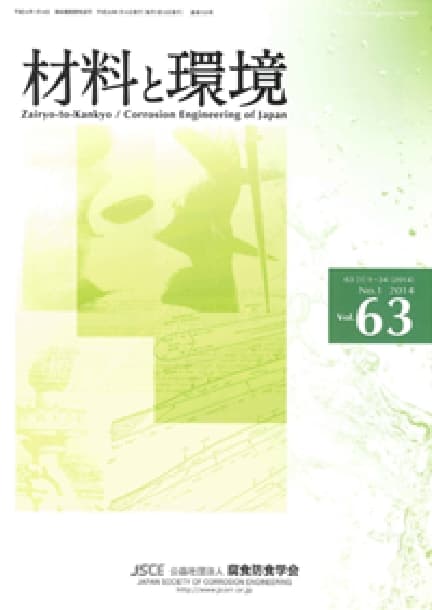- TOP
- Zairyo-to-Kankyo
- Vol. 59 (2010), No. 2
Zairyo-to-Kankyo Vol. 59 (2010), No. 2
Backnumber
-
Vol. 74 (2025)
-
Vol. 73 (2024)
-
Vol. 72 (2023)
-
Vol. 71 (2022)
-
Vol. 70 (2021)
-
Vol. 69 (2020)
-
Vol. 68 (2019)
-
Vol. 67 (2018)
-
Vol. 66 (2017)
-
Vol. 65 (2016)
-
Vol. 64 (2015)
-
Vol. 63 (2014)
-
Vol. 62 (2013)
-
Vol. 61 (2012)
-
Vol. 60 (2011)
-
Vol. 59 (2010)
-
Vol. 58 (2009)
-
Vol. 57 (2008)
-
Vol. 56 (2007)
-
Vol. 55 (2006)
-
Vol. 54 (2005)
-
Vol. 53 (2004)
-
Vol. 52 (2003)
-
Vol. 51 (2002)
-
Vol. 50 (2001)
-
Vol. 49 (2000)
-
Vol. 48 (1999)
-
Vol. 47 (1998)
-
Vol. 46 (1997)
-
Vol. 45 (1996)
-
Vol. 44 (1995)
-
Vol. 43 (1994)
-
Vol. 42 (1993)
-
Vol. 41 (1992)
-
Vol. 40 (1991)
Keyword Ranking
13 Dec. (Last 30 Days)
Zairyo-to-Kankyo Vol. 59 (2010), No. 2
Corrosion Property of Dezincing-resistant Brass in Fresh Water
Masayuki Itagaki, Nobuyuki Ashie, Hideyasu Honda, Koichi Hagiwara, Yoshiharu Kosaka, Takayasu Kisaragi
pp. 43-49
DOI:
10.3323/jcorr.59.43Abstract
Polarization curves of brass, dezincing-resistant brass and bronze were measured by channel flow double electrode (CFDE), and the electrochemical property of dezincing-resistant brass was investigated. By using CFDE, Cu(I) and Cu(II) ions dissolved from the copper-alloy electrode can be determined simultaneously during the measurement of polarization curve. The anodic polarization curve of brass was divided into two potential regions, namely, selective dissolution of zinc below 0 V vs. SSE (region I) and both dissolutions of copper and zinc above 0 V vs. SSE (region II). In the case of anodic polarization curve of dezincing-resistant brass ranked as type I by JBMA T303 test, the current was small in the region I, and the dissolution ratio of zinc was small in the region II. On the other hand, the corrosion test under the fresh water flow was carried out for brass, dezincing-resistant brass, bronze and SUS316. As the result, the dissolution morphology of dezincing-resistant brass ranked as type I tended to general corrosion even in the case that the brass showed the dezincing corrosion. In addition, the short circuit between the dezincing-resistant brass ranked as type I and SUS316 didn’t show galvanic corrosion since the corrosion potential of the dezincing-resistant brass ranked as type I is closed to that of SUS316 in the present test water.
Article Access Ranking
13 Dec. (Last 30 Days)
-
Delayed Fracture Mechanism of 1700 MPa-Class Quenched and Tempered Bolt under Atmospheric Corrosion Environment
Tetsu-to-Hagané Advance Publication
-
Perspectives on the Promising Pathways to Zero Carbon Emissions in the Steel Industry toward 2050
ISIJ International Vol.65(2025), No.2
-
Effect of B on Surface Oxidation Behavior and Phosphatability of Si-Mn-added Cold-Rolled Steel Sheets
ISIJ International Advance Publication
-
Factors Influencing the Bonding Phase Structure of Iron Ore Sinters
ISIJ International Vol.43(2003), No.9
-
Effect of microstructural heterogeneity on fatigue limit of as-quenched low-carbon low-alloy martensitic steel
ISIJ International Advance Publication
-
Prussian blue as a fully reversible hydrogenochromic material for visualizing hydrogen distribution in Fe sheet
ISIJ International Advance Publication
-
Progress of Strip Casting Technology for Steel; Historical Developments
ISIJ International Vol.52(2012), No.12
-
Research Progress on Optimal Blending of Iron Ore Powders for Sintering
ISIJ International Vol.65(2025), No.12
-
-
Microstructures and Reduction Properties of High CaO Concentration Sintered Ore
ISIJ International Advance Publication
You can use this feature after you logged into the site.
Please click the button below.










